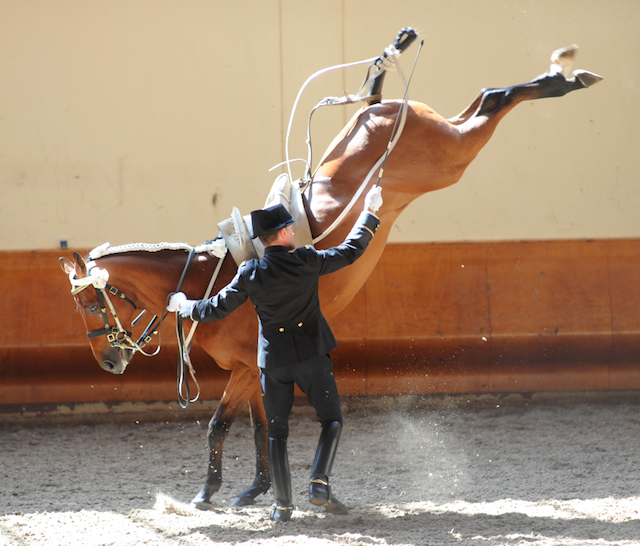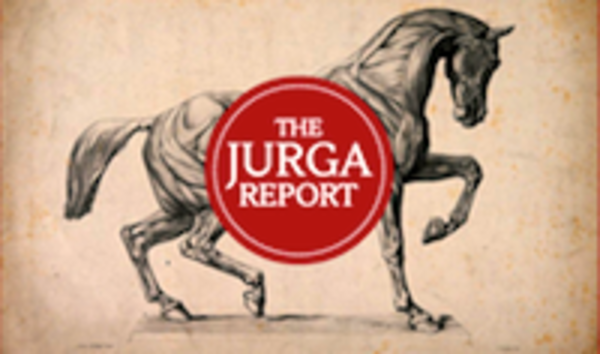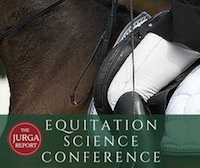ISES CONFERENCE 2016: International researchers explore the science and celebrate the art of equitation in France
- March 10, 2017
- ⎯ Fran Jurga
The magnificent ecuyers and horses of the Cadre Noir demonstrated their skill and shared their knowledge at the International Society for Equitation Science conference in June 2016 at the French National Riding School in Saumur, France. (The Jurga Report archives photo by Alain Laurioux via Wikimedia)

• • • • • • • • •
What would you get if you mixed together 183 multi-discipline speakers, demonstrators and presenters representing widespread cells of equitation research in 18 countries on six continents?
For starters, you would compile 157 pages of proceedings covering 25 oral presentations, 69 posters, eight practical demonstrations and five plenary lectures over three days of lectures and demonstrations.
The curtain fell on the 12th Annual International Equitation Science Conference in Saumur, France Sunday. Hosted by the International Society for Equitation Science (ISES), and designed to elaborate on the Society’s established core principles for training horses, this annual meeting has evolved into a shop window for academics from around the world with a horse behavior/learning-related project to share. Graduate students, doctoral candidates, faculty and researchers from colleges and universities around the world—and even a few private citizens — shared what they had done and how they did it.
The conference title for 2016 was the essence of ISES: “Understanding horses to improve training and performance”. ISES is built upon eight (or ten, depending on the version you consult) principles of utilizing a knowledge of equine ethology, or natural behavior, to improve the learning process, training or management of horses. ISES believes that a “science” of equitation is not only possible but that it is mandated: the group stands as the de facto knowledge base for those who endeavor to train horses with not only skill, but with knowledge, appreciation and conscious stewardship of the partnership between horse and human.

Science, of course, requires that results of research be repeatable and reproducible. When it comes to training horses, that is not always the case, but the science of equitation has created a boom in academic circles that had long hoped to see the 21st century expand “equine science” beyond husbandry. Since horse training was never tested under scientific principles before, opportunities for student and professional research abound, given the venue of ISES and a few other conferences where the research can be presented and defended. The void has begun to fill.
As if the setting in France’s Loire Valley wasn’t enough, the conference enjoyed a welcome by Jean-Marc Lapierre, director of the French National Riding School, and demonstrations of horse training by Colonel Patrick Teisserenc, Ecuyer en Chef of the Cadre Noir, and his Maitre Ecuyer, Fabien Godelle; the pair explained how they approach teaching the “airs above the ground” in-hand at Saumur. In particular, they discussed the trust between horse and ecuyer, and how the horse “learns behavior”, such as how to respond to the trainer’s whip.
Right on cue, the host clarified the dichotomy between art and science. “Most of us in ISES recognize that we walk a fine line between working on the science of ISES while not diminishing the art that will always be inherent to the equestrian discipline,” said Lapierre in his welcoming statement.
While much of the ISES core philosophy and ambience is suggestive of classical equitation and partnering with the horse, the ISES formula creates a bit of a melting pot of people. While many equine and veterinary science meetings are silos of ideas and practices, at ISES an academic researcher might be seated between a working horse trainer and a veterinarian, and share breakfast with a farrier, a groom, and a breeder of elite sport horses.
Sue McDonnell, PhD, Cert Applied Animal Behaviourist, founding head of the Equine Behaviour Program at Penn Vet in the United States was the lead-off academic presented. She examined the first tenet of ISES principles: train according to the horse’s ethology and cognition to stay within the interest of equine welfare and have the best road to a successful training experience and outcome.
What makes the ISES meeting so interesting is that all these researchers concur that their work is based on the group’s principles of ethology…and that the annual meetings accommodate research under a very big tent of ethological and equitational definitions. From out of this conference have come ideas that move horse training and competition ahead; ISES provides a backdrop of authority in a sport otherwise ruled by opinion and influence.

The 2016 conference included updated research on the potential problems of tight nosebands on bridles, as well as some biomechanical factors on saddle placement, problems in determining laterality in horses, and health-related investigations of feeding, sleeping, stable design, and even how many hours of turnout show jumping horses in Europe actually enjoy.
Suffice to say, for these reasons and almost 200 more: The 2016 ISES Conference proceedings book is a great read. It is also published in two editions, French and English. The research presented rarely is as basic as how horses learn a task or react to a situation in an arena or the stimulus of a certain type of bit or spur.
If you ever wondered why British riders shave their horses whiskers and German riders do not, ISES has an abstract for you. One poster at this conference questioned what a horse does when left in a stall for 24 hours. Observers videotaped and then analyzed how much time was spent standing, lying down in sternal pose, lying recumbent, moving, eating, etc. and how these behaviors were different in daytime hours compared to the middle of the night.
Riders always seem to have a lot of aches and pains, but a study of back pain in more than 300 professional riders in France showed that those who spent most of their time grooming horses had more back pain than those who spent most of their time in the saddle. Riders in that study who did have back pain reported that the pain disappeared once they were mounted.
Compare that with a study conducted at an FEI Three-Day Event in England. There 77% of riders said that they were in pain, although only about one-third said they were in pain while riding. More importantly, 71% said that they felt their performance during competition was affected by pain.
Speaking of rider pain, ISES 2016 included a poster claiming to be the first study to quantify breast motion and pain in female riders, and a lecture that detailed the effect of breast support (i.e., a sports bra) on vertical breast displacement and breast pain in different equine simulator gaits.
Interestingly, the use of riding simulators, rather than real horses, showed up in several studies. In particular, a study into stirrup pressure was an interesting switch from the prevalent studies of rein tension.
As for shaving those horse whiskers (more properly known as equine vibrissae, or sensory whiskers), the abstract reveals that in Germany it is illegal to trim them, which is why you will sometimes see them in photos of German dressage horses taken at very high resolution. However, in the UK, where trimming is not illegal, only 28% of respondents said that they trimmed them.
Interesting but esoteric abstracts aside, the presentations ran the full gamut of equine behavior, training and even biomechanics, including a presentation on the effects of arena surface footing on horses by Professor Nathalie Crevier-Denoix, head of biomechanics and clinical research in equine locomotor pathology at the Ecole Nationale Veterinaire at Alfort in Paris. Her plenary lecture, Biomechanical effects of training surfaces on the locomotor system – Impact on the horse’s health, separated surface effects between racehorses and sport horses, and emphasized the way that surface properties affect the early, mid- and late phases of the stride and what properties of footing can (and cannot) do to protect the horse’s limb and enhance movement–or to put the horse at risk for injury.
Epidemiology also factored into the mix of presentations. In addition to those mentioned, a survey of horse injuries by sport and husbandry practices in Germany found that dressage horses were the discipline most often injured. Another survey, about learning theory levels, surveyed riders on YouTube.com and found the respondents, most of whom self-identified as professional riders, unable to correctly answer questions about equitation-related learning theories.
Research, by its definition, means investigation of a question or undertaking a prescribed course of action to find possible solutions to a problem. It is an isolated and isolating effort, since extraneous details and distractions must be eliminated.
Horse ownership, riding and training, on the other hand, is truly about the development of trust and the creation of something similar to an ecosystem that surround horse and rider. ISES and its army of academic and private citizen researchers isolate individual factors of that ecosystem to analyze what is likely to contribute to horse-rider success.
ISES researchers looked in dozens of directions, but kept the individual focus narrow. Taken as a whole, their proceedings book is like a kaleidoscope video of the horse-rider interface. The fertile ecosystem between the two was prodded, queried, observed, tested, saddled and unsaddled, surveyed, and videotaped in the almost 200 research protocols.
On Sunday, the assembled scholars of equitation went home to their universities and to their stables; many reunited with the horses and colleagues who inspire and facilitate them. Some are already well into the research they will hope to present at the 2017 ISES conference, which will be held in Australia.
Until then, their batteries have been charged and they have been challenged to do more, share more, and improve the science of this sport that is so much more than just a sport. We have always known and loved the fact that there is an art to horsemanship. Now, thanks to ISES and its scientist soldiers, we can appreciate and apply the science, as well.
Fran Jurga is a freelance writer in Gloucester, Massachusetts, where she writes about horses and marine science. The AIM Equine Network has hosted her multiple award-winning articles on The Jurga Report since 2006. Follow Fran on Twitter or Facebook, and come back here to read more about the issues and problems that face our horses.









